ARP: folding/unfolding processes, enzyme reaction mechanisms, rapid binding or dissociation processes (absorbance and fluorescence).
Stopped and continuous flow: Spectroscopy for rapid kinetics (10 ms)
Applied Photophysics single-mixing SX-18
Applied Photophysics Pi-star 180
Applied Photophysics sequential-mixing DX-17MV
In the Stopped-flow instruments two different solutions are rapidly mixed and into an observation chamber. The reaction occurring in the chamber is monitored by recording the change in optical signal (Absorbance, fluorescence and circular dichroism) as a function of time.
Instrument Dead Time: 1-2ms
Typical reactions: protein-protein interactions, protein (un)folding, enzyme activity, ligand binding, Forster resonance energy transfer (FRET). Mixing might occur both in a symmetrical setup (two drive syringes of 2.5ml volume) and in asymmetrical setup (1:6 or 1:11 mixing ratio).
Typical sample requirements:
Mixing volume: a total of 150-250µl for each individual mixing shot. 3-5 individual traces are usually averaged for each experiment.
Protein concentrations: this parameter may vary for different types of experiments and should be discussed with the Facility staff.
In-house built continuous flow (original prototype) based on a capillary mixing methodology (dead-time 50 μs) with a fluorescence CCD camera.
In continuous-flow two solutions are mixed and an optical signal is recorded at different positions downstream from the mixing point. The recorded signal is converted into a time-dependent signal change on the basis of the measured flow rate.
Dead-time: ~50µs
Typical reactions: protein-protein interactions, protein (un)folding, enzyme activity, ligand binding, Forster resonance energy transfer (FRET)
Typical sample requirements:
Mixing volume: a total of 10-15ml for each individual mixing.
Protein concentrations: this parameter may vary for different types of experiments and should be discussed with the Facility staff
(T-jump): Temperature jump
Tgk Scientific Hi-Tech PTJ-64 capacitor-discharge T-jump apparatus
In the temperature-jump methodology, a rapid heating of a solution is achieved by a high-voltage discharge through an observation cell. The increase in temperature typically perturbs the equilibrium of the system, and the relaxation to a new equilibrium is observed by following the change of optical signal (absorbance, fluorescence) over time. T-jump apparatus has much shorter dead-time compared to stopped-flow and is able to resolve kinetics in µs time range.
Typical reactions: protein-protein interactions, protein (un)folding, ligand binding, Forster resonance energy transfer (FRET)
Sample requirements:
Volumes: 1.5-2ml volume of sample is required to fill the mixing chamber
Protein concentrations: this parameter may vary for different types of experiments and should be discussed with the Facility staff
Buffer: a minimum ionic strength of 150mM is required to ensure the conductivity of electricity of the solution, in order to obtain an efficient jump of temperature during the experiments
HYP-ACB: The installation uses advanced fluorescent technology for real-time biosensing of energy metabolism (Seahorse Bioscience-Agilent XFE96) in prokaryotic and eukaryotic cells under normoxic and hypoxic conditions.
SEAHORSE
Live cell metabolic biosensing
Typical sample requirements:
- Cells must be shipped to DSB-UROM 1 month before the scheduled experiments to allow the facility to cultivate the cells before the scheduled experiment.
- For bacteria: send an agar stub under controlled temperature
- For eukaryotes: send a glycerol stub in dry ice; samples must be validated as mycoplasma-free.
- Routinely, only class I cell lines and microorganisms are allowed (for higher risk class -max class II – or patients-derived samples please contact DSB-UROM)
- Send the detailed composition of media and the growth conditions
- Media should be shipped together with the cells, if one or more components do not belong to commonly used growth media (such as DMEM, RPMI or similar).
- Specific treatments (and chemicals) must be provided by the applicant.
Other requirements:
- For bacteria: typical growth temperature is 37°C. Lower temperatures can be possible but should be discussed with the Facility Staff
- For eukaryotes: in addition to normoxic experiments, for hypoxic respiratory measurements (down to 3% O2) is possible to grow cells under hypoxic conditions in the HYP-ACB facility. However, cell survival under the chosen hypoxic conditions must be verified by the applicant before sending the material.
- A declaration of the risk class of biological samples must be included in the shipment.
- A detailed protocol is mandatory and should be arranged with DSB-UROM, once application is approved.
